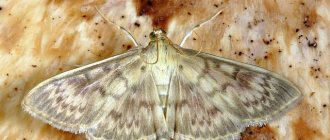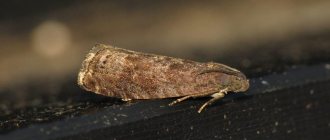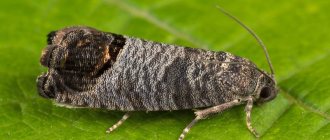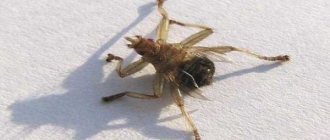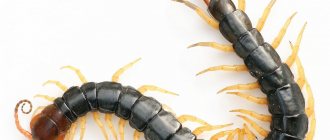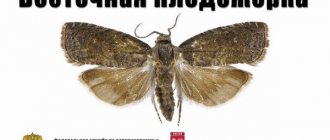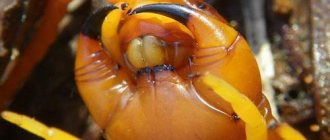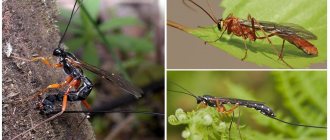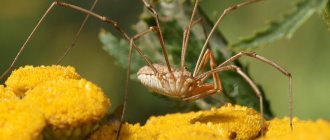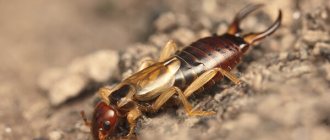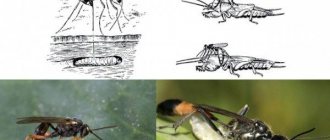The harvest of fruit trees is always a joy, because juicy fruits from your own garden can decorate any table.
Eastern moth
But the pestilence of insidious insects can interfere with planned meals: any plants are susceptible to attacks by dangerous insects.
One of the most harmful butterflies is the oriental codling moth, which can significantly reduce the qualitative and quantitative properties of the crop.
The Eastern codling moth is a dangerous quarantine insect, the source of which is considered to be in the East Asian range.
Currently, the spread of this pest has been recorded in more than 40 countries (USA, Canada, Italy, Australia, New Zealand).
The fruits and shoots of the following crops serve as food base for the harmful butterfly of the Leafworm family:
- peach;
- quince;
- pear;
- plum;
- apricot;
- Apple tree;
- nectarine;
- almond.
Damage to these crops can reach 90%, so it is important to start pest control in a timely manner. Because of its special love for peaches, this insect is sometimes called the “peach codling moth.”
Fruit damaged by the oriental codling moth
Research by agronomists has documented the amazing fertility of these butterflies: under favorable environmental conditions, insects can reproduce up to 5-6 generations per year.
The butterfly is small in size: its body barely reaches 12 mm, and its wingspan ranges from 11 to 15 mm.
Butterfly grapholita-molesta
The body of the insect is colored ash-beige, and the wings are gray-brown.
The edges of the front wings have pearlescent touches. The hind wings have fringed pubescence. Like all representatives of the Leafroll family, heterosexual individuals of grapholitha molesta busck have some differences in structure.
Eastern moth caterpillar
The bodies of females are longer than those of males. The caterpillars reach a length of 1.1 cm, and as they grow, their color changes from white to red.
Caterpillars overwinter in bark cracks, plant debris and in the top layer of soil. Caterpillars turn into pupae when the temperature reaches + 8-10 o C.
Next, sexually mature females (butterflies) begin laying 100 to 200 eggs, from which larvae hatch after a week. They bite into the shoots of plants and cause damage before the first ovaries appear; in June, the pests begin to feed on the fruits.
Pest Damage
The eastern codling moth caterpillar has become widespread across the globe.
This pest is introduced to various places as a result of movement with fruits, planting material and gardening tools.
This insect causes irreversible damage to fruit crops: the codling moth can damage up to 90% of the peach crop and up to 70% of pear and quince fruits.
Less damage is caused to plums, apricots and almonds, but these trees are also at risk.
Many people ask the question: “Why is the oriental codling moth dangerous for humans and for crops?” This insect has a distinctive feature: it is able to feed inside the shoot.
Traces of the eastern codling moth
By depriving young shoots of nutrients, the eastern codling moth dooms the stone fruit tree to inevitable death. Damaged branches wither and later break off.
The high harmfulness of the insect is explained by its high reproduction rate. The voracious larvae that fall on tree fruits bite into the juicy pulp of the fruits and attack fragile seeds and seeds. Thus, during the period of its active reproduction, this pest is capable of destroying most of the crop.
The photo of fruits damaged by the eastern codling moth shows signs of the activity of this insect. When visually examining the fruit, you can notice the passages made by the caterpillars.
Oriental moth in nectarine
The fruit also shows gum deposits caused by insect penetration. Severe damage to plant shoots leads to a lack of green mass growth.
After infection with grapholitha molesta busck caterpillars, tree fruits quickly fall off the branches and lose their marketable appearance, as a result of which they are not allowed to be sold.
Insect control methods
The fight against quarantine materials has long reached the state level: cuttings, shoots and fruits of trees infected with caterpillars are not allowed to be imported into the territory of the Russian Federation. All products in which larvae, pupae or eggs of the pest are found are subject to confiscation and processing.
Garden owners offer their own measures to combat the pest. The use of biological compounds, chemicals and folk recipes will help in exterminating dangerous insects. There are many natural remedies that the oriental codling moth does not like.
Pheromone trap for beetles
Installing pheromone traps on the site is an excellent method of control, because insects attracted by the smell quickly flock and stick to the trap. Installing trapping belts and releasing Trichogramma during egg laying are other common methods of pest control.
The folk recipes section offers many decoctions with insecticidal properties that are safe for humans.
The following decoctions are widely used:
- a decoction of onions diluted with laundry soap;
- mustard solution;
- decoction of crushed marigolds;
- decoction of dry tomato tops;
- infusion of chopped hay.
To effectively eliminate quarantine insects, it is necessary to spray fruit trees multiple times using traditional decoctions.
Conclusion
The eastern codling moth is a quarantine pest that has a very wide habitat.
An insect that damages the pulp of fruits and shoots of trees is dangerous for the crop, because it sucks out all the juices from fruit crops.
Carrying out timely preventive measures will help get rid of the harmful butterfly forever.
Video: Eastern codling moth (Grapholitha molesta Busck.)
Systematic position.
Class Insecta, order Lepidoptera, family Tortricidae, subfamily Olethreutinae, tribe Laspeyresiini, genus Grapholita.
Biological group.
Pests of fruit crops.
Morphology and biology.
The forewings are dark gray-brown, with 7 paired whitish shiny strokes along the anterior edge (wingspan 11-15 mm). The apex of the wing is bordered by a thin velvety black line, the mirror is barely noticeable. The hind wings are lighter, brownish-gray. The egg is flattened: freshly laid - white, later with an orange tint. The caterpillars are 9-13 mm long and are morphologically difficult to distinguish from the caterpillars of the plum moth. The pupa is brown, with 2 rows of spines on the tergites of the abdominal segments and 10-18 spines at the end of the abdomen. Fertility from 20 to 360 eggs. The female lays eggs one at a time on the smooth surface of leaves at the tops of young shoots, on bud scales, and later on the hairless surface of the fruit. Eggs develop in spring 6-12 days, in summer 3-6 and in autumn 5-16 days. Caterpillars invade young shoots through the upper bud. On apple and quince trees, they first mine the leaves. In the shoots, the caterpillars make moves from 11 cm from the top down to the beginning of the lignified tissue. The fruits are damaged from the moment the ovary is formed, where the cavities are eaten away, filling them with excrement. The period of development of caterpillars on peach lasts 9-12 days, on apple and quince - 16-24 days. Diapausing caterpillars of the last instar overwinter in dense silky cocoons. The average duration of pupal development is 3-11 days, depending on the generation.
Spreading.
The pest’s homeland is eastern Asia (China, Korea, Japan), from where it has spread widely. The modern range includes Central and Southern Europe, the Middle East, Northern (southern Canada, USA, Mexico) and South America, Australia, New Zealand, North and South Africa. In 1964, the pest was first found in the territory of the bay. USSR in the Sochi region, in 1965 in Azerbaijan, in 1966 in Ukraine, in 1972 in Armenia. Currently, the territories of all of Ukraine, Georgia, southern Kazakhstan (Alma-Ata, Chimkent regions), Uzbekistan (Fergana Valley), Rostov and Astrakhan regions, and the south of the Voronezh region are inhabited. (hotbed), Krasnodar and Stavropol territories, republics of the North Caucasus. Foci of seasonal colonization are regularly observed in the Kaliningrad region, Belarus, border areas of the Russian Far East, in the environs. Moscow and other centers for the mass supply of stone fruits.
Ecology.
Within the range there are at least 2 generations: in the north. Ukraine up to 3, in the south of Ukraine (including Crimea) from 3 to 5, in Georgia, Armenia and Azerbaijan from 4 to 6. Pupation in the spring begins in Ukraine at an average daily temperature of 9-10 ° C, in Armenia at 10.5-12 ° C and coincides with the opening of buds of peach and quince. Butterflies are active at temperatures above 15°C. The spring emergence period in Ukraine and in most regions of the Transcaucasus begins in mid-April, usually coinciding with the end of the peach flowering period. The duration of egg development is 6-12 days in spring, 3-6 days in summer, 3-16 days in autumn. The lifespan of adults ranges from 7 days in summer to 25 days in autumn (average about 20). The upper temperature threshold for adult activity is about 36°C. Butterflies mate in the evening. The lower temperature threshold for egg laying is 13.1-16.5°C. When the relative air humidity is less than 70%, egg laying stops and the caterpillars may have a short summer diapause. SET for the full development cycle is 338-383° (at a threshold of 10°C). Temperature optimum at high humidity is 24-29°. From the end of August, some of the caterpillars that have finished feeding begin to diapause. Factors limiting the spread are the low frost resistance of wintering caterpillars and the hygrophilicity of the active summer stages.
Economic importance.
Caterpillars damage the fruits and young shoots of various rosaceous crops: peach (preferred), quince, pear, plum, as well as apricot, apple, medlar, and cotoneaster. On cherries, cherries, cherry laurel and almonds they live mainly in the shoots, on hawthorn - only in the fruits. In total, over 80 damaged crops are known. Crop losses in many areas reach 30-40%, sometimes 50-60%. The degree of damage depends on the timing of ripening. The greatest harmfulness of the codling moth was found in areas where peach grows together with apple, pear and quince trees. Protective measures. Agrotechnical: pruning and burning damaged shoots, applying trapping belts and cleaning trunks of loose bark, collecting and destroying carrion. Biological: biological products, mass fishing and disorientation of males using pheromones. Chemical: repeated treatments with insecticides starting from the beginning of flowering of fruit trees. Quarantine measures: inspection and examination of regulated materials; regulation of the import of planting and grafting material of damaged crops from the regions where the pest is distributed.
© Ovsyannikova E.I., Grichanov I.Ya.
Photo © Neymorovets V.V. (VIZR)
Among the numerous garden pests, codling moths are especially dangerous, affecting both the formation of the crop and directly the fruits themselves. Thus, the eastern codling moth damages young shoots, ovaries and fruits of many stone fruit and pome crops: peach, apricot, plum, pear, quince, apple tree, sweet cherry, hawthorn, cherry plum and others.
The eastern codling moth is a relatively new pest for our gardens; it was first discovered in 1964 in the Krasnodar region. Over the course of 20 years, it spread to Ukraine, Moldova, the North Caucasus and the Transcaucasian republics. This is a quarantine pest.
What is he like? What are his external distinctive features and way of life?
The eastern codling moth belongs to the leaf roller family and is very similar in appearance to the widespread plum moth. The butterfly is grayish-brown in color, wingspan 12-14 mm, oval egg with a pearlescent tint. The caterpillar is 0.4-1.5 mm long, initially white with a black head, and pinkish when older. The pupa is brown, the cocoon is oval, flattened, gray.
The eastern codling moth overwinters in the caterpillar stage in a cocoon under loose bark, in cracks in the bark on a trunk, among dry leaves, in storage, etc. The flight of butterflies of the overwintered generation usually begins in April and continues until June. After 3-5 days, butterflies begin to lay eggs on the underside of leaves of young shoots of peach, plum, cherry and on the upper side of apple and quince leaves. Butterflies of summer generations also lay eggs on fruits. After 4-8 days, caterpillars hatch from the eggs, which penetrate through the top into the young shoots or into the ovaries of the fruit at the places where the stalk is attached. Damaged shoots gradually dry out. After 8-16 days, the caterpillars go to pupate and after another 5-12 days the new generation of butterflies emerge.
The full development cycle from egg to butterfly lasts an average of 24-30 days in summer. During the year, from 2 to 5 generations develop in different habitat zones.
The exceptional harmfulness of the eastern codling moth obliges us to wage a tireless fight against it. Quarantine measures, chemical, agrotechnical and biological methods are necessary.
The export of fruits, seedlings and cuttings from areas where the eastern codling moth is distributed without prior disinfection is prohibited. The export of even disinfected material requires permission from the state quarantine inspector. If a pest is detected in an area where it has not previously been observed, it is necessary to immediately report it to the State Quarantine Inspectorate.
In those places where the oriental codling moth has appeared, every gardener must carry out agrotechnical measures. They include cleaning dead bark, pruning and then burning damaged shoots, and digging up tree trunk circles. In the spring, trapping belts made of burlap or corrugated cardboard, soaked in a 1% solution of chlorophos, are placed on the trunks of fruit trees.
A fundamentally new, harmless to humans and the environment way to combat the eastern codling moth is a pheromone “trap kit”. Depending on the number of trees on the site, 2 to 4 traps are hung. Butterflies (male) codling moths fly into a trap where there is a capsule with a synthetic female sex pheromone, and are glued to a surface coated with a special glue. Plum codling moth butterflies also fly to the same pheromone.
Chemical treatments should be carried out for the first time during the period of mass flight of butterflies of the overwintered generation, the second time - 15 days after the first, the third time - after another two weeks. Treatment is carried out with insecticides approved for use on private farms: benzophosphate (10%), trichlor-metaphos-3, chlorophos and rovicurt. Benzophosphate, karbofos (10%) and trichlor-metaphos-3 (10% in our conditions) are used with a consumption rate of 60 g per 10 l of water, chlorophos - 20 g and rovikurt (25% concentrate) - 10 g per 10 liters of water. The consumption rate of working fluid is up to 2 liters for a young tree, up to 10 liters for a fruit-bearing tree. Insecticides should not be used during flowering. The last treatment should be carried out at least 30 days before harvest. It is unacceptable for drugs to come into contact with green and vegetable crops. They should be covered with film during processing.
Considering the high harmfulness of the eastern codling moth and its ability to spread quickly, measures against the pest are mandatory for everyone.
G. Makeev
, Candidate of Biological Sciences
357528, Pyatigorsk, Quarantine laboratory
(Homestead farming No. 5, 1986)
Gardeners are sounding the alarm - the oriental codling moth poses a serious threat to fruit trees and can destroy the entire crop. It is also dangerous because it is extremely prolific and spreads quickly. However, timely measures to combat the pest can help save gardens from its devastating attacks.
To cope with a pest, you need to know its habits, characteristics and habitats. This important information will help you decide what can be done to get rid of the insect. In addition, timely measures taken are the only way to save the harvest. After all, it’s no secret that belated efforts will help preserve only the remnants of the harvest or will not save anything at all. So, first you need to learn as much as possible about the malicious butterfly.
Description and lifestyle
The eastern or peach moth is a small butterfly with a wingspan of about 15 mm, belonging to the family. Its front pair of wings are painted in gray-brown tones with white-pearl strokes and black edging along the edges. The hind wings are light gray-brown in color.
Both pairs of wings of the peach moth are edged with a grayish-white fringe. The butterfly's body is dark gray. The male and female differ only in size - the female is slightly larger.
The butterfly is native to China, Japan and Korea. Currently, the eastern codling moth can be found in the southern regions of almost all continents of the planet, except Antarctica.
The eastern codling moth is a crepuscular butterfly. She is most active in the evenings and early mornings.
Females are capable of flying over a distance of no more than 50 m, and males can cover distances of up to 300 m in search of females. The eastern codling moth spreads throughout the world along with transported fruits, cuttings, seedlings and containers.
Reproduction
The eastern codling moth begins its years with the beginning of flowering of fruit trees. After mating, the female lays 100 to 200 white eggs, which become pinkish in color as they mature.
The butterfly lays one egg on the lower surface of the leaves of young shoots of plum, peach, cherry, almond, cherry and on the upper part of the leaves of quince, pear and apple trees. Females of the second and subsequent generations most often lay eggs on the sepals and stalks of fruits.
In the period from 4 to 10 days, the eggs hatch into white larvae with a black head, which, as they develop, molt 5 times and grow into caterpillars up to 13 mm in length. The body of older caterpillars is pinkish in color, and the head and chest shield become brown.
The offspring of the eastern codling moth feed on shoots and fruits of fruit trees. The development of caterpillars, depending on the type of fruit tree, lasts from 10 to 24 days, after which they begin to pupate inside the shoots, on the fruits or under the leaves. After about 5-12 days, new butterflies emerge from the cocoon.
The development cycle of one generation of the eastern codling moth averages from 24 to 40 days. Up to 6 generations of butterflies develop per season.
The last generation of caterpillars goes to winter, during which they live in the soil, under fallen leaves or under the bark of trees.
Stages of development
First a caterpillar - then a butterfly
When choosing fruit trees (apple, plum, peach), the Cydia pomonella butterfly lays eggs on the reverse (shadow) side of the leaves after a few weeks. In favorable conditions, the offspring matures so that after two weeks, caterpillars (codling moths) of bright pink color, 1.8-2.0 cm long, are born. They first absorb soft foliage. Having grown stronger, after 5 days, they gnaw through the apples. In them, the worm develops further, right up to the moment of pupation (under a layer of fallen leaves). Then everything is simple: the pupa becomes a codling moth butterfly. The photo will help you to see in detail what the codling moth looks like.
Damage caused
The eastern codling moth is one of the most dangerous pests of fruit trees. The first generation caterpillars develop in young shoots, gnawing holes up to 15 cm long in them. Damaged branches wither, crack and gradually dry out.
Infestation of a large number of shoots by caterpillars can lead to weakening and disease of the entire tree.
As the fruits ripen, the caterpillars switch to feeding on the juicy pulp of the fruit. Several caterpillars can feed on one fruit at the same time. The favorite delicacy of eastern codling moths is peach, pear and quince.
With pleasure, the caterpillars also eat cherries, plums, cherries, apricots, apples, almonds, and medlars. At the site where the caterpillars enter the fruit, gum is secreted, and the tunnels made are clearly visible under the skin of the shoots. These marks can be used to determine the presence of pests on the fruit tree.
The set fruits, eaten away by the caterpillars, rot and, before they have time to ripen, fall from the tree. Ripe fruits eaten by pests lose their marketable appearance and, as a rule, are rejected when sorted for sale. During the period of mass reproduction, the eastern codling moth can damage up to 100% of the peach crop and 70% of quince and pears.
Why is the stalk dangerous?
Apple, plum and oriental codling moths are polyphagous. Their caterpillars damage the fruits of all fruit crops, and the caterpillars of the eastern codling moth also damage young shoots. An exception is the pear codling moth (monophagous) - the nutrition and development of its caterpillars takes place in pear fruits.
For codling moth caterpillars, fruits are a pantry and a reliable shelter, where they are located from birth to full development. By feeding on the pulp and seeds of fruits, they disrupt their normal development. The caterpillars of the plum moth, in addition, interrupt the supply of nutrients to the fruits by gnawing through their vascular system. Fruits damaged by caterpillars rot and fall off, reducing the yield. Damage to fruits at a later date spoils their commercial quality, they become unsuitable for sale and, as a rule, are rejected during commercial sorting.
Protection and control measures
The fight against the eastern codling moth is aimed at reducing the number and curbing the spread of the pest. In garden farms, agrotechnical, biological and chemical control measures are used:
Chemical treatment is carried out three times per season with an interval of 15 days, starting during the spring mass flight of butterflies. It is strictly forbidden to treat fruit trees with insecticides during flowering.
The last application is carried out 30 days or more before harvest. The following drugs are used to control the pest:
- Benzophosphate - 60 g per 10 liters of water;
- Chlorophos - 20 g per 10 liters of water;
- Karbofos (10%) - 60 g per 10 liters of water;
- Rovikurt (25%) - 10 g per 10 liters of water;
- Trichlor-metaphos-3 (10%) - 60 g per 10 liters of water.
The solution consumption rate is 10 liters per fruit-bearing tree and 2 liters per young tree. During the processing of fruit trees, all other crops are covered with film.
The eastern codling moth is on the list of quarantine insects. Fruits, cuttings and seedlings imported into Russia are checked by the state quarantine inspection. If the oriental codling moth is detected, the products are disinfected. The export of fruit from infected Russian regions without disinfection is prohibited and requires permission from a quarantine inspector.
Of course, the eastern codling moth is a dangerous and insidious enemy that can cause enormous damage to gardening. However, the pest can and should be fought. By using effective means and methods to combat the voracious insect, you can successfully protect the grown crop.
Gardeners are seriously concerned: there is a threat of losing the harvest of fruit trees. And the culprit for this is the eastern codling moth. Why is this harmless-looking butterfly dangerous? The main danger is not only that this insect is capable of making devastating raids on gardens, but also that it is extremely prolific and can spread very quickly. Therefore, in order to save the remains of the harvest or be left without anything at all, it is necessary to prepare in advance to fight the harmful butterfly. And for this you need to know its lifestyle, reproduction characteristics, measures to combat it and methods of protection. More on all this below.
How to destroy armyworms and their caterpillars on different vegetables
Armyworm larvae prefer to feed on tomato leaves, cabbage seedlings and young potato shoots. If you do not start fighting the pest in a timely manner, you may lose the entire crop on the site.
Potato scoop
In addition to the general methods of exterminating insects, the main features of the fight against potato cutworms should be noted:
- Regular weeding of potato beds from weeds, especially cereal plants;
- Using insecticides twice a season - for cultivating the soil and spraying plants.
IMPORTANT: Do not plant tomatoes next to potato beds - cutworms can easily jump from one plant to another.
Cabbage moth butterfly
The fight against insects on cabbage consists of the following steps:
- Deep digging of the soil after harvesting and before planting seedlings;
- Try to plant cabbage seedlings in open ground as early as possible in order to avoid mass infection of young plants;
- Regular inspection of cabbage and manual collection of detected larvae (caterpillars);
- Feeding cabbage seedlings with potassium chloride and superphosphates;
- Use of folk recipes and biological products.
IMPORTANT: Chemical treatment of cabbage is recommended only when the above methods do not work.
Scoop on tomatoes
The set of measures to destroy butterflies and caterpillars is generally similar to the control methods described above for potatoes and cabbage. However, some characteristic features should be noted:
Weed weeds regularly, paying special attention to loboda and nettles; Do not allow weeds to reappear in the tomato beds; Use biological products - only use chemicals if there is no effect.
Description
The eastern codling moth, which is called the peach moth because of its special love for peaches, is not very large in size: the wingspan is about 1.1-1.5 cm. The front wings are gray-brown in color and have pearlescent streaks, and the hind wings are light-colored. There is no such decoration on brown wings. There is a grayish-white fringe along the edges of both pairs of wings. The difference between females and males is body size: females are slightly longer.
The pest's caterpillars reach a length of 0.9-1.1 cm. At the first stage of growth, their body is white and their head is black. As they grow older, the caterpillars change body color to red and their heads to brown.
Features of reproduction
The caterpillars survive the winter in cocoons, from which they emerge early in the spring. When stone fruit trees bloom, butterflies begin to fly. A little later, when the fruits begin to ripen, the butterflies will lay eggs. For this they choose leaves, shoots and, of course, fruits. Each individual can lay from one hundred to two hundred eggs. After 5-10 days, the larvae will hatch.
Having hatched, the caterpillars penetrate into the young shoots through the upper buds. They then chew out an exit hole, which they use to move on to the next shoot. The ability to feed inside a shoot is inherent only in the eastern codling moth - this distinguishes it from other similar pests.
Damaged branches begin to wither and subsequently dry out. Those larvae of the eastern codling moth that fall on the fruits bite into the pulp, unhardened seeds and seeds. Moreover, on one, for example, peach there can be up to 10 pieces.
After the caterpillars have finished feeding, they begin to pupate, choosing for this purpose damaged shoots, fruits or any other shelters in the crown of trees. After a short period of time, butterflies emerge from the pupae. In just one season, an adult butterfly can give 4-6 generations. Moreover, by the middle of the season, the first generation has already laid eggs, so you can encounter all stages of the harmful insect at the same time.
At a time when the codling moth begins to multiply en masse, it can completely destroy the entire crop of peaches, and 70-75% of quinces and pears.
Cabbage pests: leaf beetle, cabbage fly
The cabbage fly is a flying insect that in appearance resembles an ordinary fly, but its body size is more compact and is about 5 mm. The fly begins its destructive activities in May, when it begins laying eggs. The laying is carried out directly into the ground, in close proximity to the cabbage seedlings. After about 10 days, the eggs hatch into voracious larvae that feed on tender roots.
It is not difficult to determine whether a plant is affected by cabbage fly. The plant begins to lag in growth and looks lethargic. As the root system deteriorates, symptoms become more obvious. Initially, the lower leaves acquire a lead color, and after a few days the plant dies completely.
The photo shows the cabbage leaf beetle and its larva
If you notice something is wrong, you need to water the beds with Thiophos solution or spray the cabbage with dust. Traditional methods help by watering the soil next to the bushes with vinegar essence at the rate of 1 tablespoon per 10 liters of water. It is quite effective to sprinkle the rows with tobacco dust, mothballs, mustard, and hot pepper.
Cabbage leaf d is a small green bug that itself is not dangerous to the plant. However, it lays eggs, from which larvae hatch and readily eat cabbage. As a result, the farmer notices the appearance of characteristic damage on the leaves, as shown in the photo.
Tobacco dust, ash, slaked lime - these are time-tested substances that can be sprayed on cabbage. It is possible to catch insects using glue traps placed on the garden bed. Using poisons is guaranteed to help get rid of the leaf beetle. The preparations “Karate” and “Aktara” will quickly destroy beetles and their larvae.
Cabbage pests: bugs and cutworms
Cabbage bugs are very prolific pests that feed on plant sap. A characteristic light spot forms at the site of the bite, as can be seen in the photo. Bacteria, viruses and fungi can penetrate through the wound, causing various cabbage diseases.
The photo shows a cabbage bug and a lightened area of the affected leaf.
Cabbage bugs are repelled by naphthalene, which is pre-mixed with sand and scattered between the beds. Spraying the leaves with tobacco, a decoction of potato tops with onion peels are safe but effective methods of control. Chemical preparations “Phosbecid” or “Belofos” will help get rid of insects even during massive attacks.
The moth moth is an insect that reproduces quickly, especially in the southern regions of Russia. The butterfly lays eggs, which it attaches to the bottom of the leaf. Soon voracious larvae emerge, actively feeding on cabbage leaves and gnawing holes in them. The pest is predominantly nocturnal, hiding during the day at the base of the cabbage stem. The use of traditional repellents and poisons allows you to get rid of cutworms on cabbage.
Pictured is a cabbage cutworm and its caterpillar
Caterpillars are a fairly common problem. Among various insects, the ones that most often cause damage to crops are:
- Cabbage white caterpillar. It has a yellow-green color, a body length of up to 6 cm. The caterpillar is generously covered with long hairs and has a good appetite.
- Turnip white. The caterpillar is green in color and eats only the tender flesh, but ignores the veins, leaving the leaf skeleton intact.
- Rapeseed sawfly larvae. They eat leaves, causing significant damage to the plant.
For effective prevention, it is worth inspecting the leaves every few days and mechanically destroying the pest eggs found on them. For chemical control, the drugs “Kemifos”, “Inta-vir”, “Creotsid” are used. Plantings are sprayed with solutions of these poisons. A positive result comes quite quickly.
Cabbage pests and how to deal with them using folk remedies
The photo shows pest eggs attached to the back of a cabbage leaf.
Farmers increasingly prefer to grow vegetables without the use of chemicals and potent products. This is correct, because even if all safety rules are followed, a small amount of hazardous substances still gets into the ground and can penetrate the human body. What folk remedies can be used to control cabbage pests? We invite you to familiarize yourself with the most popular of them, namely:
Video about cabbage pests and methods of controlling them:
Dangerous cabbage pests cause enormous damage to farms every year. Photos of insects and a description of effective methods of combating them will help the vegetable grower quickly recognize dangerous symptoms and destroy them. You can also preserve the harvest using folk methods, which will allow you to harvest cabbage without harmful substances and good for health.
Habitat
Although the butterfly’s homeland is the eastern part of Asia, in particular China, Korea, and Japan, today it can be found on almost all continents of the planet, with the exception of Antarctica. How could an insect cover such distances? And it migrated not on its own, but with the help of man: during the transportation of cuttings, seedlings and fruits around the world, almost invisible larvae and eggs of a harmful butterfly were transported along with them. Now, wherever quinces, pears, peaches, and apple trees grow and bear fruit, the eastern codling moth appears. Photos on the Internet depicting various fruits infected with insects of this species confirm the fact of its distribution on all continents.
Geographical distribution
The homeland of the eastern codling moth is considered to be China, Korea and Japan. Nowadays, the pest belongs to species common in the subtropical and southern temperate zones. In the Russian Federation and in the post-Soviet space it is found in the Astrakhan region, Stavropol and Krasnodar, North Caucasus regions, Belarus, Ukraine, Moldova, Lithuania.
In Europe, the eastern codling moth has been recorded in Austria, Germany, France, Switzerland, Italy, Spain, Poland, Romania, Hungary, Bulgaria, and the Czech Republic.
The codling moth also originated from the warm climate of Eurasia. And since the main factors limiting the spread of the codling moth are average temperatures below +12°, today they can be found almost everywhere where apple trees are found.
Signs of infection
The oriental codling moth mainly lives on peach, but other fruit trees are also infected:
- Medlar.
- Almond.
- Apple tree.
- Apricot.
- Cherries.
- Plum.
- Cherry.
It is not difficult to notice the appearance of a butterfly: in those places where the pest penetrates the fruit, gum appears, and the passages made under the bark are clearly visible. Caterpillars damage the fruits that have set, and before they have time to ripen, they fall off the tree. And those fruits that remain on the tree are usually already infected and quickly lose their marketable appearance, which is why they are rejected and not allowed for sale.
Reader questions:
Do starlings on an apple tree eat caterpillars?
Although there is information circulating on the Internet that these birds feed on the caterpillars of this harmful insect, this is not so. They are pecked en masse only by different types of tits, and then only at the moment they emerge from the apples and crawl to their wintering areas.
Flowers protecting the apple tree from worms
Another “panacea” for worms in apples from the Internet, especially spread by supporters of “BIO-farming”, is planting special types of flowers under apple trees that scare and kill the pest.
It’s a pity, but this method cannot give anything other than disappointment and a crop lost from the pest, because biology is not “led” by fashion trends, and the butterfly does not die only from the smells of plants.
Regular treatment of apple trees against codling moths in the summer will provide many tasty apples in the fall and winter!
Preventive measures
Conventional prevention can have a great effect. Of course, it will be effective in the first stages of infection, when the eastern codling moth has just begun to occupy the garden. What needs to be done to prevent excessive infection? The following measures have an excellent effect:
- Removing dead bark from large branches and trunks. If this is not done, then a huge number of caterpillars will remain overwintering under the bark, in cracks, and then next year it will be very difficult to fight the pest.
- Destruction of plant residues, including carrion. Moreover, you need to collect fallen fruits every evening and not leave them overnight: at night, the caterpillars crawl out of the carrion to move to the tree. Therefore, fallen fruits must either be destroyed or buried very deeply, at least 0.5 m.
- Disinfection of containers.
- Digging up the soil in autumn, spring and summer, when the eastern codling moth is in the pupal stage. Moreover, it is necessary to dig not only around tree trunks, but also between rows. Such a measure will significantly reduce the number of harmful insects on the site.
- Regular cutting and burning of damaged shoots.
In addition, it is necessary to arrange bait in the crowns to attract butterflies. You can also place catching belts made of corrugated paper, burlap or other materials soaked in chlorophos on the supports to catch the caterpillars, which, having emerged from the fallen fruits, are looking for a place for pupation or feeding.
Traps for oriental moths
Hunting belts are easy to make with your own hands. Any rags, corrugated paper, rubber, or plastic film are suitable for their manufacture. Plastic bottles are often used for young trees. The trapping belt can be a funnel, a trap with an adhesive surface, or a belt soaked in an insecticidal solution.
To make a funnel, you will need cardboard at least 20-25 cm wide, the length is determined by the thickness of the trunk. The upper part of the structure should fit snugly against the tree, and the lower part should retreat at least 5 cm. The trap is attached with rope, twine, and electrical tape.
The main advantage of dry fishing belts is environmental friendliness and safety. Such devices are most effective in the spring.
To prevent mass invasion, glue or insecticidal traps are used. To create the device, you need to moisten a rag 30-35 cm wide generously in an insecticidal solution. Wrap it around the trunk and cover it with film on top. Secure the entire structure with rope.
To build a sticky trap, wrap the trunk with paper and cover it with garden glue, tar, and resin. To protect fruit trees from the oriental codling moth, different types of traps can be used simultaneously.
Pheromone traps are also used for male moths. The main purpose of the devices is not so much to catch insects, but to determine the feasibility of carrying out pest control work. If more than 5 individuals are found in the trap, the trees are sprayed with chemicals.
Biological methods
There are many natural remedies that the oriental codling moth does not like. Measures to combat them require time and labor, but the destruction of such a serious enemy of any garden is worth it.
Various chemicals are used when the insect has multiplied so abundantly that other methods of control are powerless. What is the eastern codling moth afraid of? Why is treating a garden with chemicals dangerous for humans? To prevent people or animals from being harmed, it is imperative to adhere to the instructions and recommendations of specialists. And the very first thing you need to know and follow: under no circumstances should you cultivate the garden during the flowering period or during harvesting.
It is best to use the following drugs to destroy the pest (the norms are based on 10 liters of water):
- "Trichlor-metaphos-3" - 60 g of 10% preparation.
- "Rovikurt" - 10 g.
- "Chlorophos" - 20 g;
- "Karbofos" - 60 g;
- "Chlorophos benzophosphate" - 60 g.
For each fruit-bearing adult tree, you need to use 10 liters of solution; for a young plant, two liters is enough. During treatment, all other plants must be covered with film.
conclusions
The eastern codling moth is a quarantine insect. All seedlings, cuttings and fruits that are imported into the territory of Russia, exported from it or moved around the country are necessarily checked by the state quarantine inspection. If even the slightest signs of insect infestation of any type of product are detected, it will be subject to disinfection, and in too severe cases, destruction.
Thanks to this, it is possible to localize foci of infection and partially prevent the spread of the pest. This serves as proof that, despite the treachery of a dangerous enemy, it is possible to fight him, and quite successfully. The main thing is not to hesitate and not to give up, and then you can find a way out of the most difficult situation and protect your garden and harvest.

